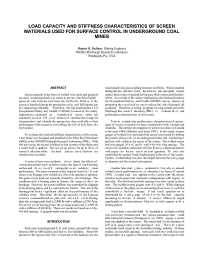Mining Publication: Load Capacity and Stiffness Characteristics of Screen Materials Used for Surface Control in Underground Coal Mines
Original creation date: August 2006
Screen material in the form of welded wire mesh and geogrids are used in underground coal mines to prevent the fall of small pieces of rock from the roof between roof bolts. Further, if the screen is installed during the production cycle, roof fall injuries can be reduced significantly. Therefore, the National Institute for Occupational Safety and Health (NIOSH), because of the safety implications, conducted an evaluation of screen materials commonly used in U.S. coal mines to determine their support characteristics and identify the parameters that could affect their performance with respect to controlling the fall of rock from the roof surface. To evaluate the load and stiffness characteristics of the screen, a test frame was designed and installed in the Mine Roof Simulator (MRS) at the NIOSH Pittsburgh Research Laboratory (PRL). With this test set up, the screen is bolted at four corners of the frame and a center load is applied. The test set up allows for up to 20 in of screen deflection while the load and screen defection are continuously recorded. A series of tests were conducted to evaluate the effects of various parameters such as bolt tension, the type of load bearing surface and the size of bearing plates on welded screen performance. The most common screen material used in U. S. coal mines is an 8-gauge wire welded in a 4-by-4-in spacing or aperture. The peak screen load was normally limited by wire breakage. The conditions at the bearing plate influence the nature of the wire breakage. However, the screen stiffness was controlled by slippage at the bearing plates, and by weld and wire failure. The size of the bearing plate had a significant effect on the performance of the welded screen. Therefore, the design capacity of the 8-gauge screen is evaluated based on plate size. For a 6-by-6-in bearing plate the average peak load is 2,900 lb with a stiffness of 250 lb/in. For an 8-by-8-in bearing plate, the average peak load is 4,500 lb with a stiffness of 430 lb/in. These test results are based on a 4-by-4-ft bolt spacing. A geogrid mesh was also tested.
Authors: DR Dolinar
Conference Paper - August 2006
NIOSHTIC2 Number: 20030808
Proceedings of 25th International Conference on Ground Control in Mining, August 1-3, 2006, Morgantown, West Virginia. Peng SS, Mark C, Finfinger G, Tadolini S, Khair AW, Heasley K, Luo Y, eds., Morgantown, WV: West Virginia University, 2006 Aug; :152-158
See Also
- Best Practices and Bolting Machine Innovations for Roof Screening
- External L5-S1 Joint Moments When Lifting Wire Mesh Screen Used to Prevent Rock Falls in Underground Mines
- Make it Safer with Roof Screen
- Optimizing Secondary Roof Support with the NIOSH Support Technology Optimization Program (STOP)
- Performance Characteristics for Welded Wire Screen Used for Surface Control in Underground Coal Mines
- Potential of Roof Screening to Reduce Workers’ Compensation Cost
- Reduced Workers’ Compensation Costs With Roof Screening
- Roof Screening: Best Practices and Roof Bolting Machines
- Technology News 483 - Safety Training Tools for Rock Scaling Personnel
- Technology News 508 - NIOSH Releases New Safety Video: Make It Safer With Roof Screen
- Page last reviewed: 9/21/2012
- Page last updated: 9/21/2012
- Content source: National Institute for Occupational Safety and Health, Mining Program


 ShareCompartir
ShareCompartir
